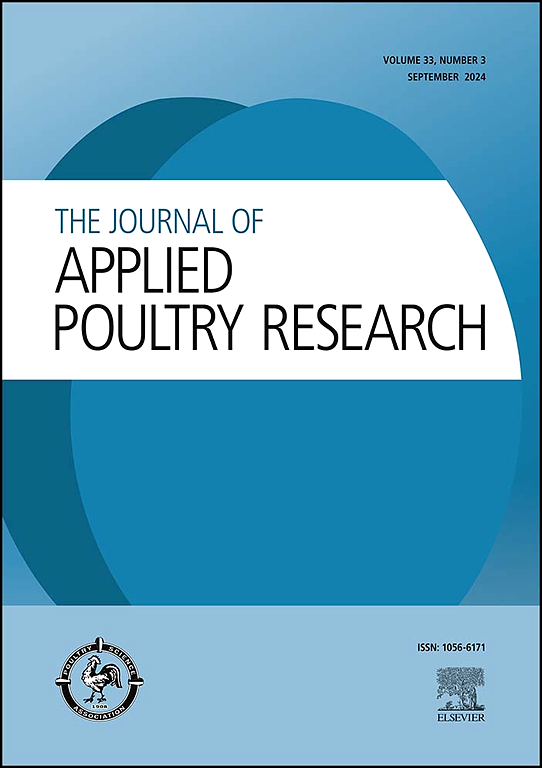应用研究说明:确定宾夕法尼亚州获得美国农业部豁免的家禽加工的规模和范围
IF 2
3区 农林科学
Q2 AGRICULTURE, DAIRY & ANIMAL SCIENCE
引用次数: 0
摘要
为了有效地教育宾夕法尼亚州的小规模家禽生产者在保护商业家禽产业中的作用,首先了解该州获得美国农业部豁免的家禽加工的规模和范围是至关重要的。这项研究旨在从该州10个家禽密度最大的地区收集数据,为未来的推广规划提供信息。肉鸟密度最高的县包括兰开斯特、黎巴嫩、伯克斯、斯奈德、朱尼亚塔、联合、斯库尔基尔、约克、佩里和富兰克林。使用Qualtrics开发了一项包含七个问题的匿名调查,以确定种植者的位置,其加工操作的性质以及相关的豁免类别。调查的分发具有挑战性,农贸市场和加工设施的回应有限。然而,一对一的对话和通过宾夕法尼亚州立大学扩展列表服务的额外扩展提供了有价值的见解。大多数受访者在前10个县以外的地方饲养鸟类,72.6%的人在农场使用个人设备进行加工。肉鸡是最常见的品种,近一半的受访者饲养多个品种。“个人使用”豁免类别最常被选择(47.0%),尽管许多生产商不确定他们正确的豁免类别。此外,59.7%的人缺乏书面的生物安全计划。这些发现表明对美国农业部豁免的认识严重不足,可能是由于执法和监督有限。鉴于小规模养殖场的分散性质,未来的推广工作应扩大到家禽密集的县以外,并重新评估其对商业产业的潜在风险。本文章由计算机程序翻译,如有差异,请以英文原文为准。
Applied research note: Determining the size and scope of USDA-exempted poultry processing in Pennsylvania
To effectively educate small-scale poultry producers in Pennsylvania on their role in protecting commercial poultry industries, it is essential to first understand the size and scope of USDA-exempt poultry processing in the state. This study aimed to gather data from the state's 10 most poultry-dense regions to inform future extension programming. The counties identified with the highest meat bird densities included Lancaster, Lebanon, Berks, Snyder, Juniata, Union, Schuylkill, York, Perry, and Franklin. A seven-question anonymous survey was developed using Qualtrics to identify the location of growers, the nature of their processing operations, and the relevant exemption categories. Distribution of the survey was challenging, with limited responses from farmers' markets and processing facilities. However, one-on-one conversations and additional outreach via the Penn State Extension ListServ provided valuable insights. Most respondents raised birds outside the top 10 counties, with 72.6 % processing on-farm using personal equipment. Broilers were the most common species, and nearly half of the respondents raised multiple species. The "Personal Use" exemption category was most frequently selected (47.0 %), although many producers were unsure of their correct exemption category. Additionally, 59.7 % lacked a written biosecurity plan. These findings indicate a significant lack of awareness about USDA exemptions, likely due to limited enforcement and oversight. Given the dispersed nature of small-scale farms, future extension efforts should expand beyond poultry-dense counties and reassess their potential risks to the commercial industry.
求助全文
通过发布文献求助,成功后即可免费获取论文全文。
去求助
来源期刊

Journal of Applied Poultry Research
农林科学-奶制品与动物科学
CiteScore
4.10
自引率
10.50%
发文量
80
审稿时长
104 days
期刊介绍:
The Journal of Applied Poultry Research (JAPR) publishes original research reports, field reports, and reviews on breeding, hatching, health and disease, layer management, meat bird processing and products, meat bird management, microbiology, food safety, nutrition, environment, sanitation, welfare, and economics. As of January 2020, JAPR will become an Open Access journal with no subscription charges, meaning authors who publish here can make their research immediately, permanently, and freely accessible worldwide while retaining copyright to their work. Papers submitted for publication after October 1, 2019 will be published as Open Access papers.
The readers of JAPR are in education, extension, industry, and government, including research, teaching, administration, veterinary medicine, management, production, quality assurance, product development, and technical services. Nutritionists, breeder flock supervisors, production managers, microbiologists, laboratory personnel, food safety and sanitation managers, poultry processing managers, feed manufacturers, and egg producers use JAPR to keep up with current applied poultry research.
 求助内容:
求助内容: 应助结果提醒方式:
应助结果提醒方式:


